Effectiveness of Braden Scale in ICU Pressure Injury Assessment Review
VerifiedAdded on 2023/03/30
|31
|6225
|197
Report
AI Summary
This research proposal outlines a systematic review designed to evaluate the effectiveness of the Braden Scale as a tool for assessing the risk of pressure injuries among patients in intensive care units (ICUs). The proposal includes a detailed background on pressure ulcers, their impact on ICU patients, and the rationale for using the Braden Scale. It presents the research question, objectives, and the PICO framework (Population, Intervention, Comparison, Outcome) to guide the review. The methodology section describes the review design, eligibility criteria for study inclusion, search strategy, evidence appraisal, and analysis plan. Ethical considerations, dissemination plans, and a timeline for completion are also included. The study aims to synthesize evidence from primary studies published within the last ten years to determine if the Braden Scale is an effective assessment tool for identifying ICU patients at risk of developing pressure ulcers, thereby informing early interventions and improving patient outcomes. The proposal also includes appendices with inclusion/exclusion criteria, search strategies, and the PRISMA flow diagram.
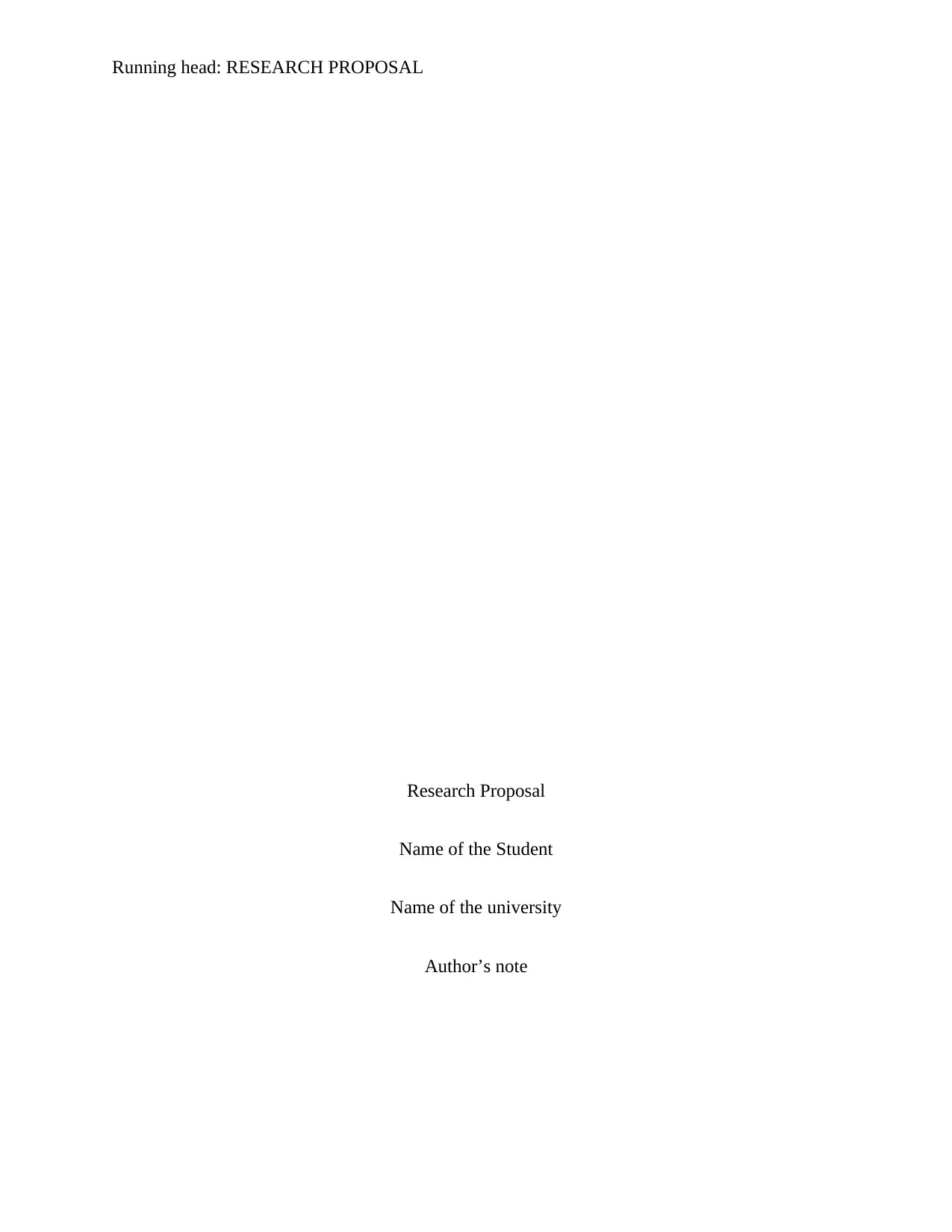
Running head: RESEARCH PROPOSAL
Research Proposal
Name of the Student
Name of the university
Author’s note
Research Proposal
Name of the Student
Name of the university
Author’s note
Paraphrase This Document
Need a fresh take? Get an instant paraphrase of this document with our AI Paraphraser
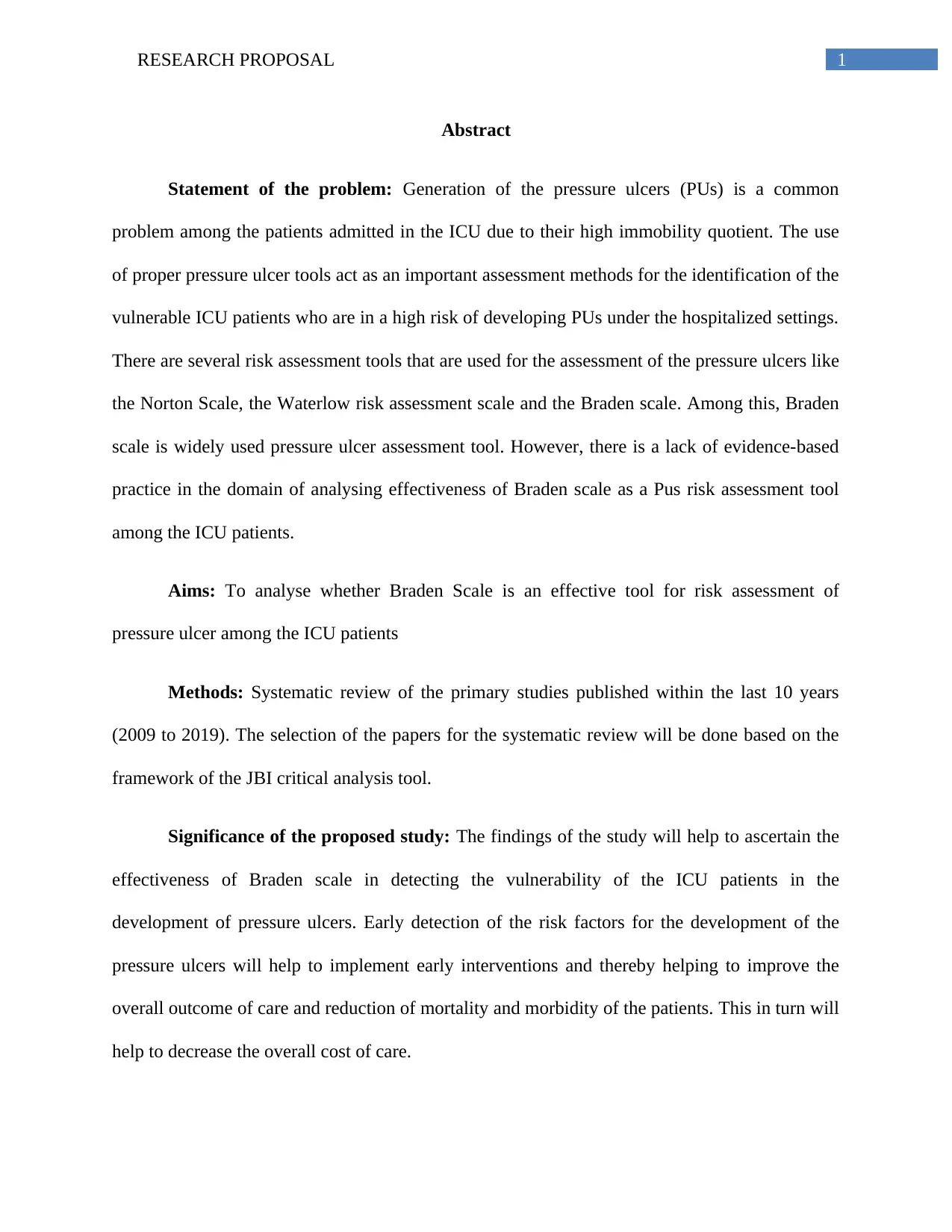
1RESEARCH PROPOSAL
Abstract
Statement of the problem: Generation of the pressure ulcers (PUs) is a common
problem among the patients admitted in the ICU due to their high immobility quotient. The use
of proper pressure ulcer tools act as an important assessment methods for the identification of the
vulnerable ICU patients who are in a high risk of developing PUs under the hospitalized settings.
There are several risk assessment tools that are used for the assessment of the pressure ulcers like
the Norton Scale, the Waterlow risk assessment scale and the Braden scale. Among this, Braden
scale is widely used pressure ulcer assessment tool. However, there is a lack of evidence-based
practice in the domain of analysing effectiveness of Braden scale as a Pus risk assessment tool
among the ICU patients.
Aims: To analyse whether Braden Scale is an effective tool for risk assessment of
pressure ulcer among the ICU patients
Methods: Systematic review of the primary studies published within the last 10 years
(2009 to 2019). The selection of the papers for the systematic review will be done based on the
framework of the JBI critical analysis tool.
Significance of the proposed study: The findings of the study will help to ascertain the
effectiveness of Braden scale in detecting the vulnerability of the ICU patients in the
development of pressure ulcers. Early detection of the risk factors for the development of the
pressure ulcers will help to implement early interventions and thereby helping to improve the
overall outcome of care and reduction of mortality and morbidity of the patients. This in turn will
help to decrease the overall cost of care.
Abstract
Statement of the problem: Generation of the pressure ulcers (PUs) is a common
problem among the patients admitted in the ICU due to their high immobility quotient. The use
of proper pressure ulcer tools act as an important assessment methods for the identification of the
vulnerable ICU patients who are in a high risk of developing PUs under the hospitalized settings.
There are several risk assessment tools that are used for the assessment of the pressure ulcers like
the Norton Scale, the Waterlow risk assessment scale and the Braden scale. Among this, Braden
scale is widely used pressure ulcer assessment tool. However, there is a lack of evidence-based
practice in the domain of analysing effectiveness of Braden scale as a Pus risk assessment tool
among the ICU patients.
Aims: To analyse whether Braden Scale is an effective tool for risk assessment of
pressure ulcer among the ICU patients
Methods: Systematic review of the primary studies published within the last 10 years
(2009 to 2019). The selection of the papers for the systematic review will be done based on the
framework of the JBI critical analysis tool.
Significance of the proposed study: The findings of the study will help to ascertain the
effectiveness of Braden scale in detecting the vulnerability of the ICU patients in the
development of pressure ulcers. Early detection of the risk factors for the development of the
pressure ulcers will help to implement early interventions and thereby helping to improve the
overall outcome of care and reduction of mortality and morbidity of the patients. This in turn will
help to decrease the overall cost of care.
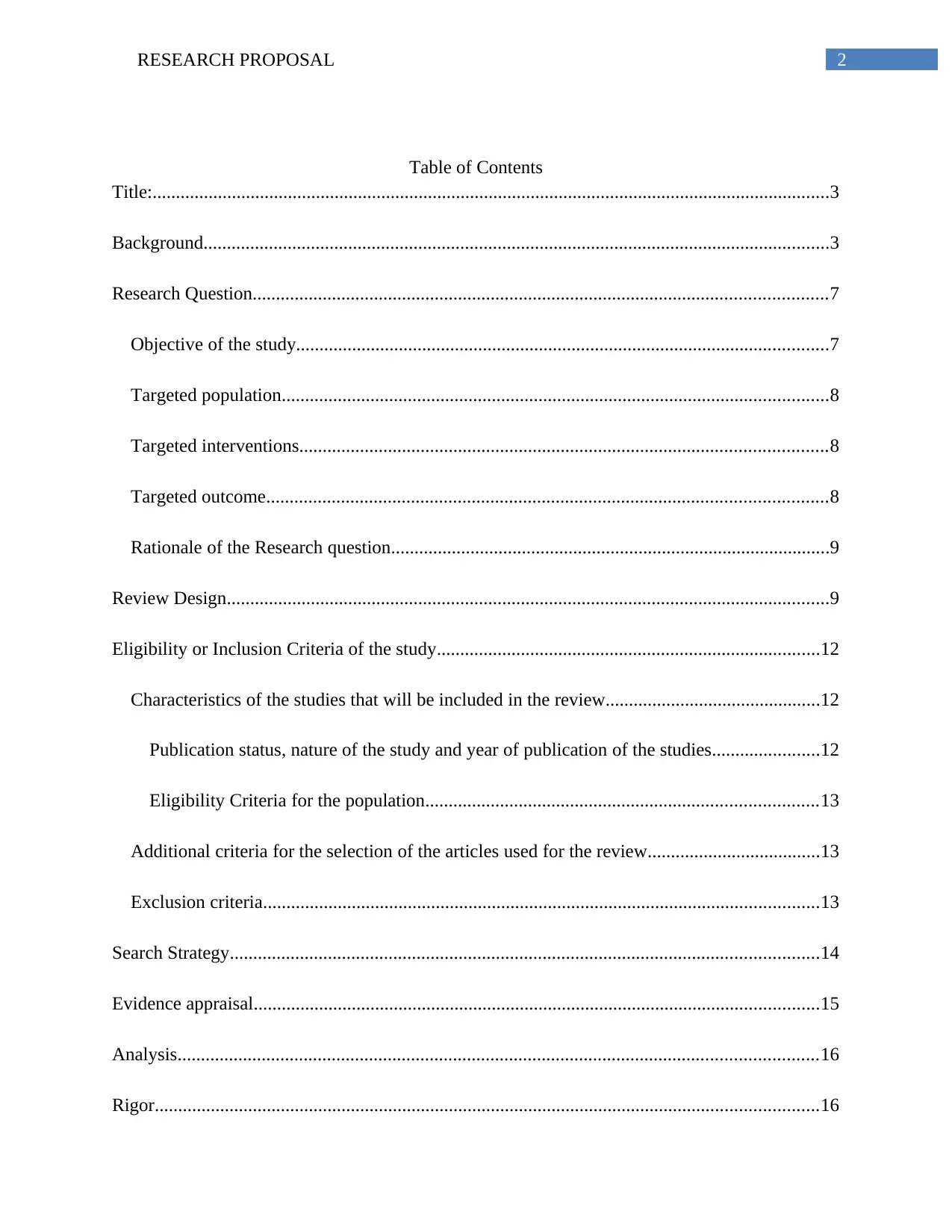
2RESEARCH PROPOSAL
Table of Contents
Title:.................................................................................................................................................3
Background......................................................................................................................................3
Research Question...........................................................................................................................7
Objective of the study..................................................................................................................7
Targeted population.....................................................................................................................8
Targeted interventions.................................................................................................................8
Targeted outcome........................................................................................................................8
Rationale of the Research question..............................................................................................9
Review Design.................................................................................................................................9
Eligibility or Inclusion Criteria of the study..................................................................................12
Characteristics of the studies that will be included in the review..............................................12
Publication status, nature of the study and year of publication of the studies.......................12
Eligibility Criteria for the population....................................................................................13
Additional criteria for the selection of the articles used for the review.....................................13
Exclusion criteria.......................................................................................................................13
Search Strategy..............................................................................................................................14
Evidence appraisal.........................................................................................................................15
Analysis.........................................................................................................................................16
Rigor..............................................................................................................................................16
Table of Contents
Title:.................................................................................................................................................3
Background......................................................................................................................................3
Research Question...........................................................................................................................7
Objective of the study..................................................................................................................7
Targeted population.....................................................................................................................8
Targeted interventions.................................................................................................................8
Targeted outcome........................................................................................................................8
Rationale of the Research question..............................................................................................9
Review Design.................................................................................................................................9
Eligibility or Inclusion Criteria of the study..................................................................................12
Characteristics of the studies that will be included in the review..............................................12
Publication status, nature of the study and year of publication of the studies.......................12
Eligibility Criteria for the population....................................................................................13
Additional criteria for the selection of the articles used for the review.....................................13
Exclusion criteria.......................................................................................................................13
Search Strategy..............................................................................................................................14
Evidence appraisal.........................................................................................................................15
Analysis.........................................................................................................................................16
Rigor..............................................................................................................................................16
⊘ This is a preview!⊘
Do you want full access?
Subscribe today to unlock all pages.

Trusted by 1+ million students worldwide
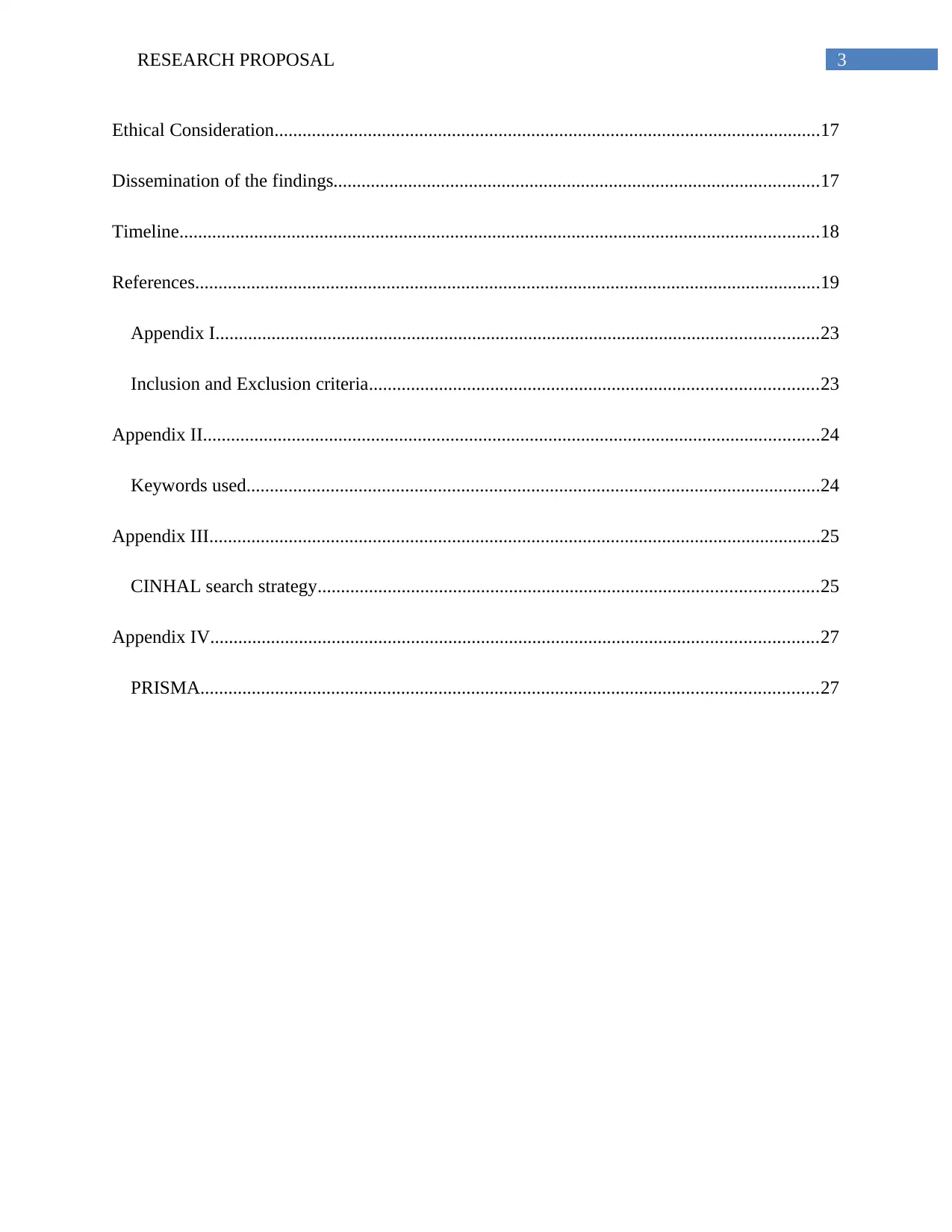
3RESEARCH PROPOSAL
Ethical Consideration.....................................................................................................................17
Dissemination of the findings........................................................................................................17
Timeline.........................................................................................................................................18
References......................................................................................................................................19
Appendix I.................................................................................................................................23
Inclusion and Exclusion criteria................................................................................................23
Appendix II....................................................................................................................................24
Keywords used...........................................................................................................................24
Appendix III...................................................................................................................................25
CINHAL search strategy...........................................................................................................25
Appendix IV..................................................................................................................................27
PRISMA....................................................................................................................................27
Ethical Consideration.....................................................................................................................17
Dissemination of the findings........................................................................................................17
Timeline.........................................................................................................................................18
References......................................................................................................................................19
Appendix I.................................................................................................................................23
Inclusion and Exclusion criteria................................................................................................23
Appendix II....................................................................................................................................24
Keywords used...........................................................................................................................24
Appendix III...................................................................................................................................25
CINHAL search strategy...........................................................................................................25
Appendix IV..................................................................................................................................27
PRISMA....................................................................................................................................27
Paraphrase This Document
Need a fresh take? Get an instant paraphrase of this document with our AI Paraphraser
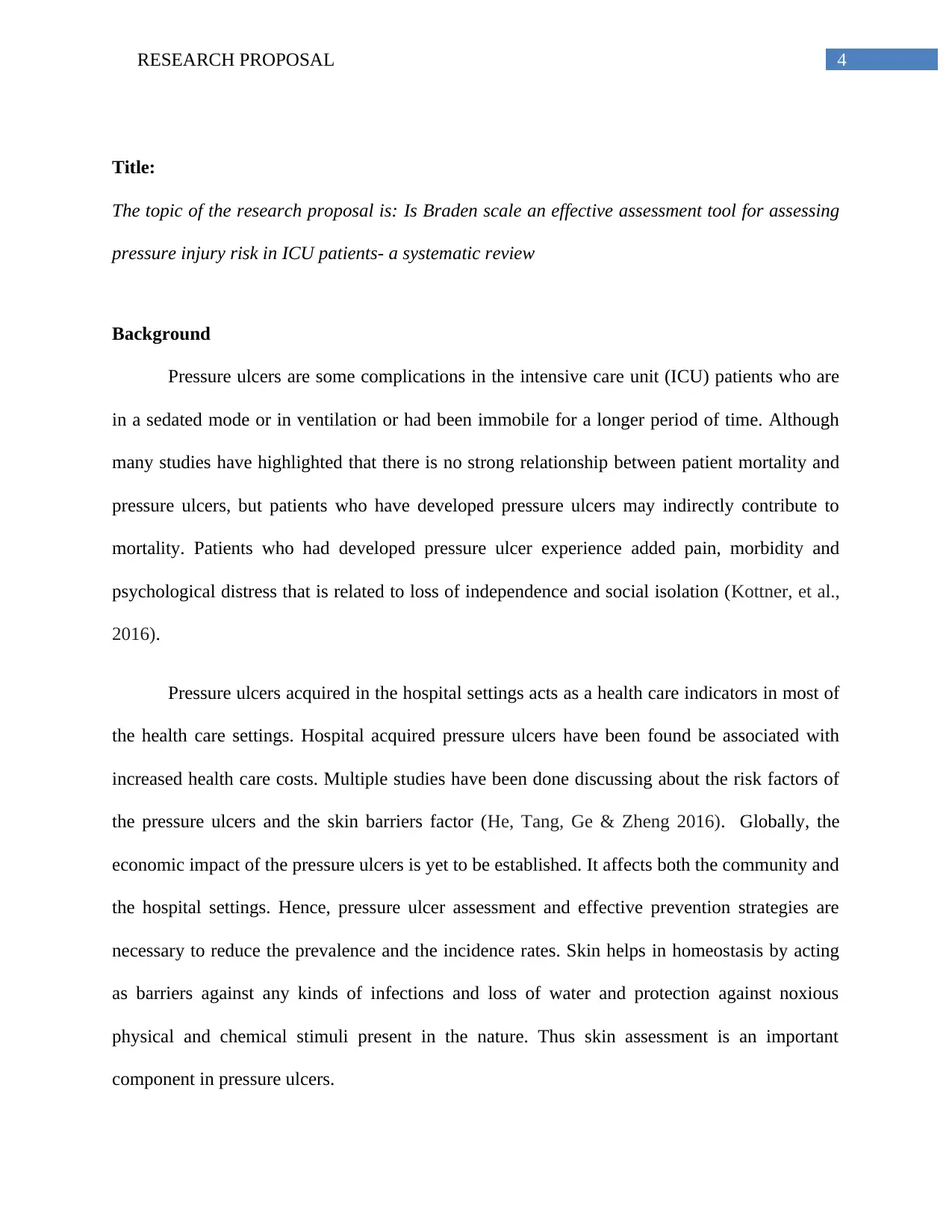
4RESEARCH PROPOSAL
Title:
The topic of the research proposal is: Is Braden scale an effective assessment tool for assessing
pressure injury risk in ICU patients- a systematic review
Background
Pressure ulcers are some complications in the intensive care unit (ICU) patients who are
in a sedated mode or in ventilation or had been immobile for a longer period of time. Although
many studies have highlighted that there is no strong relationship between patient mortality and
pressure ulcers, but patients who have developed pressure ulcers may indirectly contribute to
mortality. Patients who had developed pressure ulcer experience added pain, morbidity and
psychological distress that is related to loss of independence and social isolation (Kottner, et al.,
2016).
Pressure ulcers acquired in the hospital settings acts as a health care indicators in most of
the health care settings. Hospital acquired pressure ulcers have been found be associated with
increased health care costs. Multiple studies have been done discussing about the risk factors of
the pressure ulcers and the skin barriers factor (He, Tang, Ge & Zheng 2016). Globally, the
economic impact of the pressure ulcers is yet to be established. It affects both the community and
the hospital settings. Hence, pressure ulcer assessment and effective prevention strategies are
necessary to reduce the prevalence and the incidence rates. Skin helps in homeostasis by acting
as barriers against any kinds of infections and loss of water and protection against noxious
physical and chemical stimuli present in the nature. Thus skin assessment is an important
component in pressure ulcers.
Title:
The topic of the research proposal is: Is Braden scale an effective assessment tool for assessing
pressure injury risk in ICU patients- a systematic review
Background
Pressure ulcers are some complications in the intensive care unit (ICU) patients who are
in a sedated mode or in ventilation or had been immobile for a longer period of time. Although
many studies have highlighted that there is no strong relationship between patient mortality and
pressure ulcers, but patients who have developed pressure ulcers may indirectly contribute to
mortality. Patients who had developed pressure ulcer experience added pain, morbidity and
psychological distress that is related to loss of independence and social isolation (Kottner, et al.,
2016).
Pressure ulcers acquired in the hospital settings acts as a health care indicators in most of
the health care settings. Hospital acquired pressure ulcers have been found be associated with
increased health care costs. Multiple studies have been done discussing about the risk factors of
the pressure ulcers and the skin barriers factor (He, Tang, Ge & Zheng 2016). Globally, the
economic impact of the pressure ulcers is yet to be established. It affects both the community and
the hospital settings. Hence, pressure ulcer assessment and effective prevention strategies are
necessary to reduce the prevalence and the incidence rates. Skin helps in homeostasis by acting
as barriers against any kinds of infections and loss of water and protection against noxious
physical and chemical stimuli present in the nature. Thus skin assessment is an important
component in pressure ulcers.
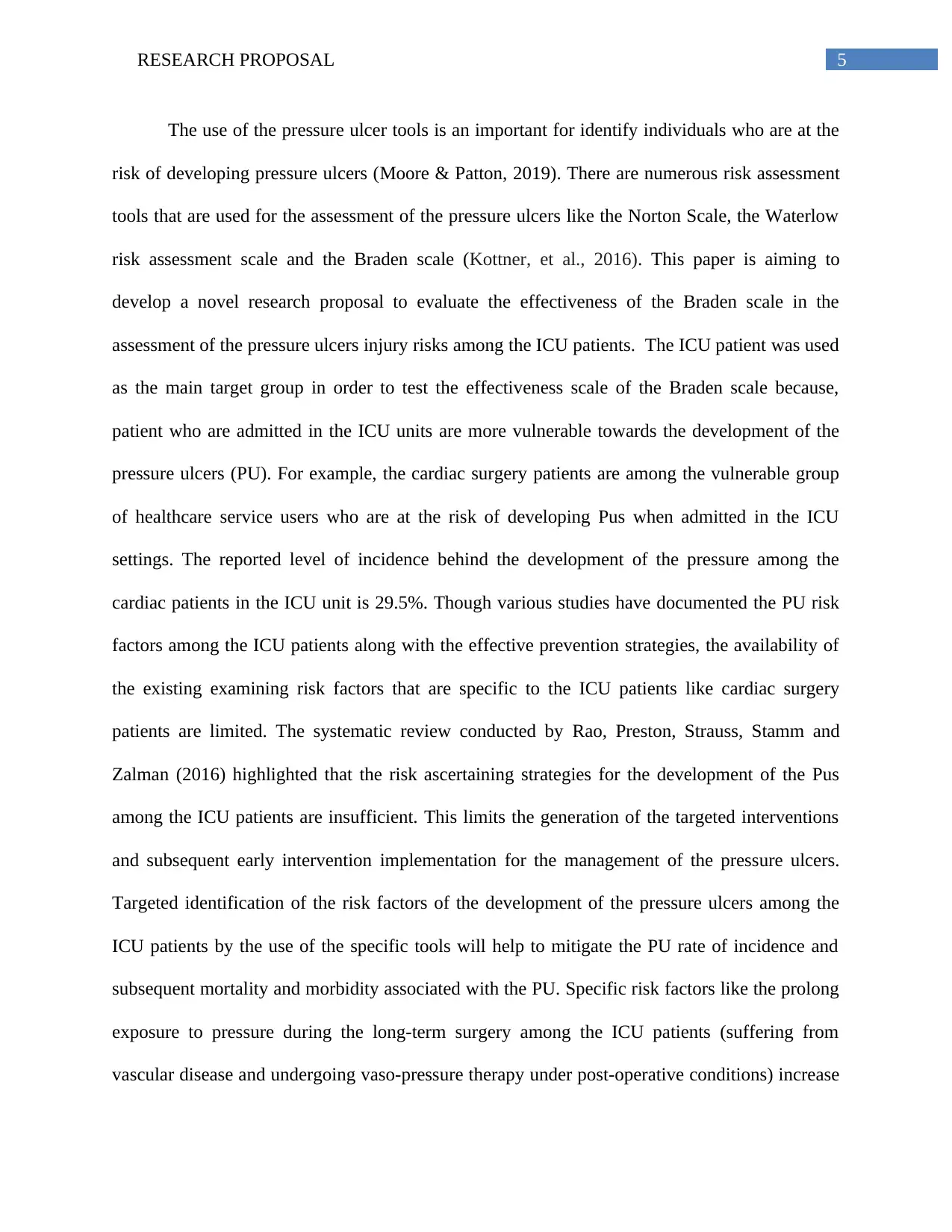
5RESEARCH PROPOSAL
The use of the pressure ulcer tools is an important for identify individuals who are at the
risk of developing pressure ulcers (Moore & Patton, 2019). There are numerous risk assessment
tools that are used for the assessment of the pressure ulcers like the Norton Scale, the Waterlow
risk assessment scale and the Braden scale (Kottner, et al., 2016). This paper is aiming to
develop a novel research proposal to evaluate the effectiveness of the Braden scale in the
assessment of the pressure ulcers injury risks among the ICU patients. The ICU patient was used
as the main target group in order to test the effectiveness scale of the Braden scale because,
patient who are admitted in the ICU units are more vulnerable towards the development of the
pressure ulcers (PU). For example, the cardiac surgery patients are among the vulnerable group
of healthcare service users who are at the risk of developing Pus when admitted in the ICU
settings. The reported level of incidence behind the development of the pressure among the
cardiac patients in the ICU unit is 29.5%. Though various studies have documented the PU risk
factors among the ICU patients along with the effective prevention strategies, the availability of
the existing examining risk factors that are specific to the ICU patients like cardiac surgery
patients are limited. The systematic review conducted by Rao, Preston, Strauss, Stamm and
Zalman (2016) highlighted that the risk ascertaining strategies for the development of the Pus
among the ICU patients are insufficient. This limits the generation of the targeted interventions
and subsequent early intervention implementation for the management of the pressure ulcers.
Targeted identification of the risk factors of the development of the pressure ulcers among the
ICU patients by the use of the specific tools will help to mitigate the PU rate of incidence and
subsequent mortality and morbidity associated with the PU. Specific risk factors like the prolong
exposure to pressure during the long-term surgery among the ICU patients (suffering from
vascular disease and undergoing vaso-pressure therapy under post-operative conditions) increase
The use of the pressure ulcer tools is an important for identify individuals who are at the
risk of developing pressure ulcers (Moore & Patton, 2019). There are numerous risk assessment
tools that are used for the assessment of the pressure ulcers like the Norton Scale, the Waterlow
risk assessment scale and the Braden scale (Kottner, et al., 2016). This paper is aiming to
develop a novel research proposal to evaluate the effectiveness of the Braden scale in the
assessment of the pressure ulcers injury risks among the ICU patients. The ICU patient was used
as the main target group in order to test the effectiveness scale of the Braden scale because,
patient who are admitted in the ICU units are more vulnerable towards the development of the
pressure ulcers (PU). For example, the cardiac surgery patients are among the vulnerable group
of healthcare service users who are at the risk of developing Pus when admitted in the ICU
settings. The reported level of incidence behind the development of the pressure among the
cardiac patients in the ICU unit is 29.5%. Though various studies have documented the PU risk
factors among the ICU patients along with the effective prevention strategies, the availability of
the existing examining risk factors that are specific to the ICU patients like cardiac surgery
patients are limited. The systematic review conducted by Rao, Preston, Strauss, Stamm and
Zalman (2016) highlighted that the risk ascertaining strategies for the development of the Pus
among the ICU patients are insufficient. This limits the generation of the targeted interventions
and subsequent early intervention implementation for the management of the pressure ulcers.
Targeted identification of the risk factors of the development of the pressure ulcers among the
ICU patients by the use of the specific tools will help to mitigate the PU rate of incidence and
subsequent mortality and morbidity associated with the PU. Specific risk factors like the prolong
exposure to pressure during the long-term surgery among the ICU patients (suffering from
vascular disease and undergoing vaso-pressure therapy under post-operative conditions) increase
⊘ This is a preview!⊘
Do you want full access?
Subscribe today to unlock all pages.

Trusted by 1+ million students worldwide
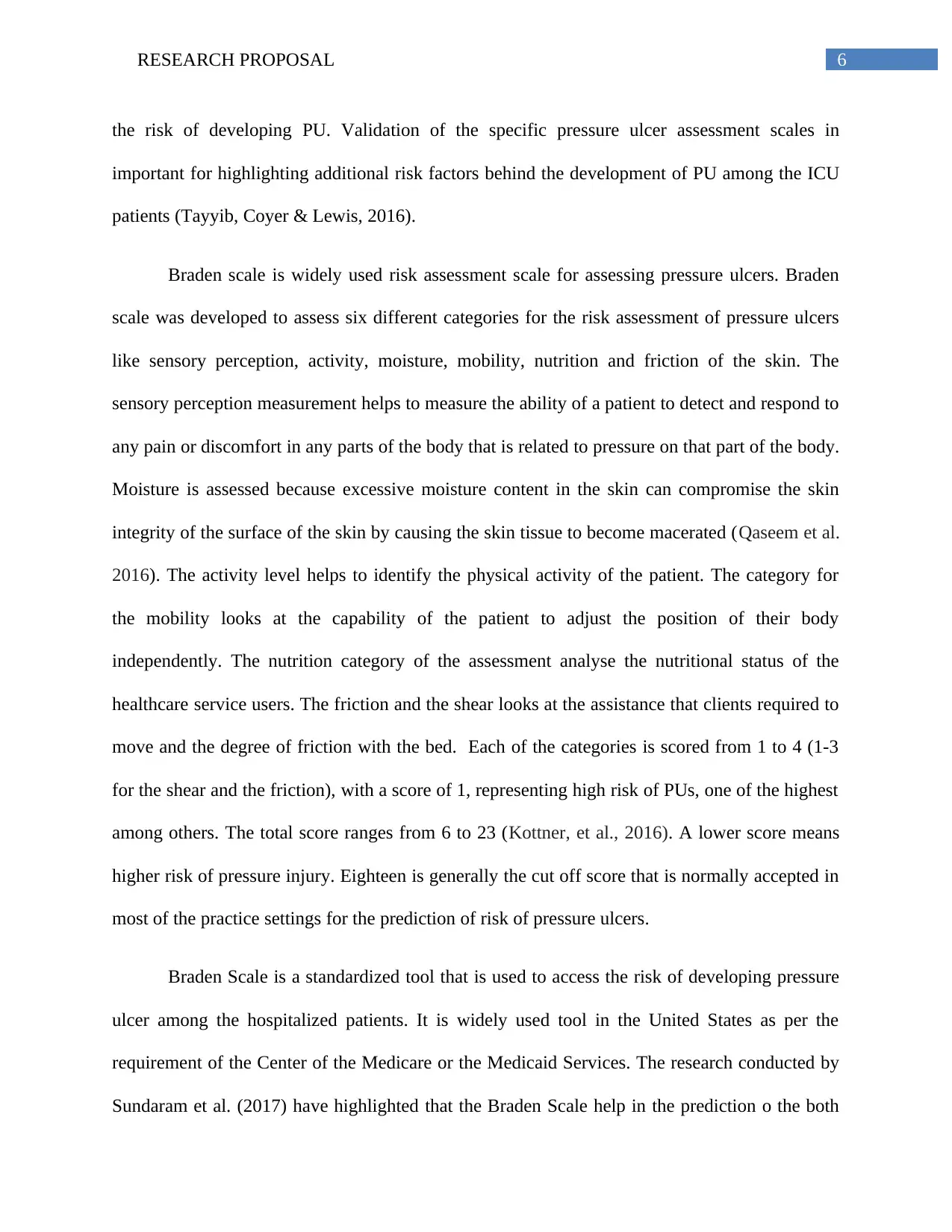
6RESEARCH PROPOSAL
the risk of developing PU. Validation of the specific pressure ulcer assessment scales in
important for highlighting additional risk factors behind the development of PU among the ICU
patients (Tayyib, Coyer & Lewis, 2016).
Braden scale is widely used risk assessment scale for assessing pressure ulcers. Braden
scale was developed to assess six different categories for the risk assessment of pressure ulcers
like sensory perception, activity, moisture, mobility, nutrition and friction of the skin. The
sensory perception measurement helps to measure the ability of a patient to detect and respond to
any pain or discomfort in any parts of the body that is related to pressure on that part of the body.
Moisture is assessed because excessive moisture content in the skin can compromise the skin
integrity of the surface of the skin by causing the skin tissue to become macerated (Qaseem et al.
2016). The activity level helps to identify the physical activity of the patient. The category for
the mobility looks at the capability of the patient to adjust the position of their body
independently. The nutrition category of the assessment analyse the nutritional status of the
healthcare service users. The friction and the shear looks at the assistance that clients required to
move and the degree of friction with the bed. Each of the categories is scored from 1 to 4 (1-3
for the shear and the friction), with a score of 1, representing high risk of PUs, one of the highest
among others. The total score ranges from 6 to 23 (Kottner, et al., 2016). A lower score means
higher risk of pressure injury. Eighteen is generally the cut off score that is normally accepted in
most of the practice settings for the prediction of risk of pressure ulcers.
Braden Scale is a standardized tool that is used to access the risk of developing pressure
ulcer among the hospitalized patients. It is widely used tool in the United States as per the
requirement of the Center of the Medicare or the Medicaid Services. The research conducted by
Sundaram et al. (2017) have highlighted that the Braden Scale help in the prediction o the both
the risk of developing PU. Validation of the specific pressure ulcer assessment scales in
important for highlighting additional risk factors behind the development of PU among the ICU
patients (Tayyib, Coyer & Lewis, 2016).
Braden scale is widely used risk assessment scale for assessing pressure ulcers. Braden
scale was developed to assess six different categories for the risk assessment of pressure ulcers
like sensory perception, activity, moisture, mobility, nutrition and friction of the skin. The
sensory perception measurement helps to measure the ability of a patient to detect and respond to
any pain or discomfort in any parts of the body that is related to pressure on that part of the body.
Moisture is assessed because excessive moisture content in the skin can compromise the skin
integrity of the surface of the skin by causing the skin tissue to become macerated (Qaseem et al.
2016). The activity level helps to identify the physical activity of the patient. The category for
the mobility looks at the capability of the patient to adjust the position of their body
independently. The nutrition category of the assessment analyse the nutritional status of the
healthcare service users. The friction and the shear looks at the assistance that clients required to
move and the degree of friction with the bed. Each of the categories is scored from 1 to 4 (1-3
for the shear and the friction), with a score of 1, representing high risk of PUs, one of the highest
among others. The total score ranges from 6 to 23 (Kottner, et al., 2016). A lower score means
higher risk of pressure injury. Eighteen is generally the cut off score that is normally accepted in
most of the practice settings for the prediction of risk of pressure ulcers.
Braden Scale is a standardized tool that is used to access the risk of developing pressure
ulcer among the hospitalized patients. It is widely used tool in the United States as per the
requirement of the Center of the Medicare or the Medicaid Services. The research conducted by
Sundaram et al. (2017) have highlighted that the Braden Scale help in the prediction o the both
Paraphrase This Document
Need a fresh take? Get an instant paraphrase of this document with our AI Paraphraser
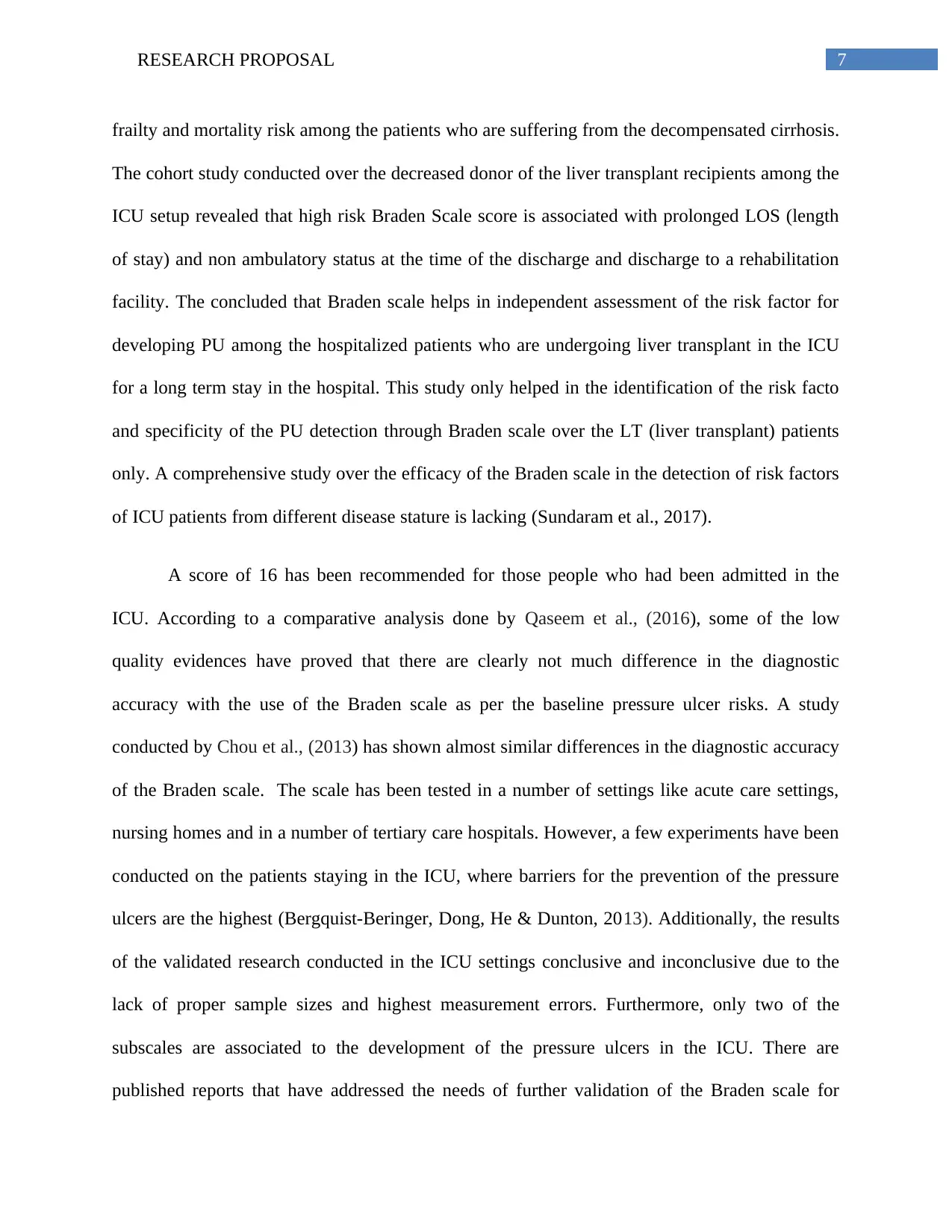
7RESEARCH PROPOSAL
frailty and mortality risk among the patients who are suffering from the decompensated cirrhosis.
The cohort study conducted over the decreased donor of the liver transplant recipients among the
ICU setup revealed that high risk Braden Scale score is associated with prolonged LOS (length
of stay) and non ambulatory status at the time of the discharge and discharge to a rehabilitation
facility. The concluded that Braden scale helps in independent assessment of the risk factor for
developing PU among the hospitalized patients who are undergoing liver transplant in the ICU
for a long term stay in the hospital. This study only helped in the identification of the risk facto
and specificity of the PU detection through Braden scale over the LT (liver transplant) patients
only. A comprehensive study over the efficacy of the Braden scale in the detection of risk factors
of ICU patients from different disease stature is lacking (Sundaram et al., 2017).
A score of 16 has been recommended for those people who had been admitted in the
ICU. According to a comparative analysis done by Qaseem et al., (2016), some of the low
quality evidences have proved that there are clearly not much difference in the diagnostic
accuracy with the use of the Braden scale as per the baseline pressure ulcer risks. A study
conducted by Chou et al., (2013) has shown almost similar differences in the diagnostic accuracy
of the Braden scale. The scale has been tested in a number of settings like acute care settings,
nursing homes and in a number of tertiary care hospitals. However, a few experiments have been
conducted on the patients staying in the ICU, where barriers for the prevention of the pressure
ulcers are the highest (Bergquist-Beringer, Dong, He & Dunton, 2013). Additionally, the results
of the validated research conducted in the ICU settings conclusive and inconclusive due to the
lack of proper sample sizes and highest measurement errors. Furthermore, only two of the
subscales are associated to the development of the pressure ulcers in the ICU. There are
published reports that have addressed the needs of further validation of the Braden scale for
frailty and mortality risk among the patients who are suffering from the decompensated cirrhosis.
The cohort study conducted over the decreased donor of the liver transplant recipients among the
ICU setup revealed that high risk Braden Scale score is associated with prolonged LOS (length
of stay) and non ambulatory status at the time of the discharge and discharge to a rehabilitation
facility. The concluded that Braden scale helps in independent assessment of the risk factor for
developing PU among the hospitalized patients who are undergoing liver transplant in the ICU
for a long term stay in the hospital. This study only helped in the identification of the risk facto
and specificity of the PU detection through Braden scale over the LT (liver transplant) patients
only. A comprehensive study over the efficacy of the Braden scale in the detection of risk factors
of ICU patients from different disease stature is lacking (Sundaram et al., 2017).
A score of 16 has been recommended for those people who had been admitted in the
ICU. According to a comparative analysis done by Qaseem et al., (2016), some of the low
quality evidences have proved that there are clearly not much difference in the diagnostic
accuracy with the use of the Braden scale as per the baseline pressure ulcer risks. A study
conducted by Chou et al., (2013) has shown almost similar differences in the diagnostic accuracy
of the Braden scale. The scale has been tested in a number of settings like acute care settings,
nursing homes and in a number of tertiary care hospitals. However, a few experiments have been
conducted on the patients staying in the ICU, where barriers for the prevention of the pressure
ulcers are the highest (Bergquist-Beringer, Dong, He & Dunton, 2013). Additionally, the results
of the validated research conducted in the ICU settings conclusive and inconclusive due to the
lack of proper sample sizes and highest measurement errors. Furthermore, only two of the
subscales are associated to the development of the pressure ulcers in the ICU. There are
published reports that have addressed the needs of further validation of the Braden scale for
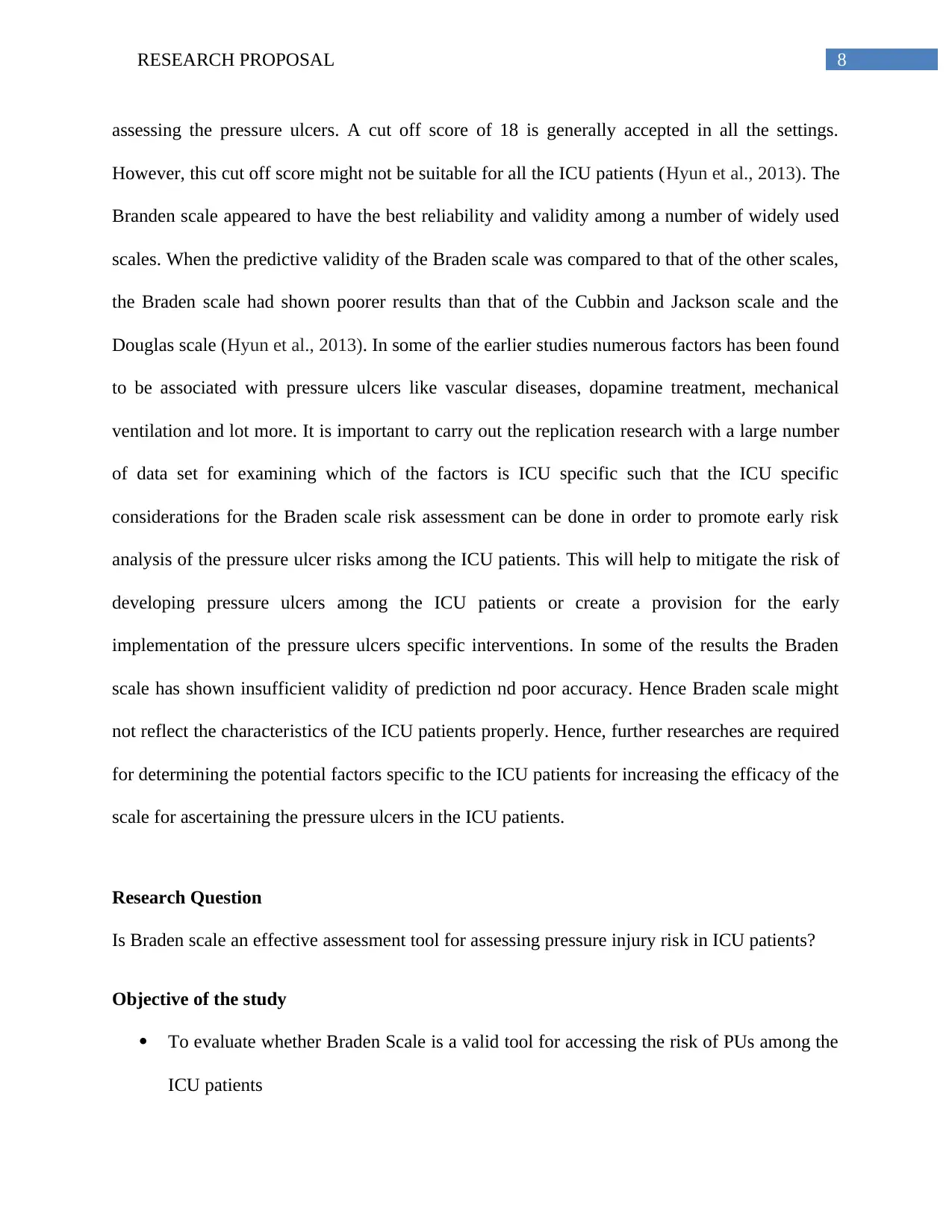
8RESEARCH PROPOSAL
assessing the pressure ulcers. A cut off score of 18 is generally accepted in all the settings.
However, this cut off score might not be suitable for all the ICU patients (Hyun et al., 2013). The
Branden scale appeared to have the best reliability and validity among a number of widely used
scales. When the predictive validity of the Braden scale was compared to that of the other scales,
the Braden scale had shown poorer results than that of the Cubbin and Jackson scale and the
Douglas scale (Hyun et al., 2013). In some of the earlier studies numerous factors has been found
to be associated with pressure ulcers like vascular diseases, dopamine treatment, mechanical
ventilation and lot more. It is important to carry out the replication research with a large number
of data set for examining which of the factors is ICU specific such that the ICU specific
considerations for the Braden scale risk assessment can be done in order to promote early risk
analysis of the pressure ulcer risks among the ICU patients. This will help to mitigate the risk of
developing pressure ulcers among the ICU patients or create a provision for the early
implementation of the pressure ulcers specific interventions. In some of the results the Braden
scale has shown insufficient validity of prediction nd poor accuracy. Hence Braden scale might
not reflect the characteristics of the ICU patients properly. Hence, further researches are required
for determining the potential factors specific to the ICU patients for increasing the efficacy of the
scale for ascertaining the pressure ulcers in the ICU patients.
Research Question
Is Braden scale an effective assessment tool for assessing pressure injury risk in ICU patients?
Objective of the study
To evaluate whether Braden Scale is a valid tool for accessing the risk of PUs among the
ICU patients
assessing the pressure ulcers. A cut off score of 18 is generally accepted in all the settings.
However, this cut off score might not be suitable for all the ICU patients (Hyun et al., 2013). The
Branden scale appeared to have the best reliability and validity among a number of widely used
scales. When the predictive validity of the Braden scale was compared to that of the other scales,
the Braden scale had shown poorer results than that of the Cubbin and Jackson scale and the
Douglas scale (Hyun et al., 2013). In some of the earlier studies numerous factors has been found
to be associated with pressure ulcers like vascular diseases, dopamine treatment, mechanical
ventilation and lot more. It is important to carry out the replication research with a large number
of data set for examining which of the factors is ICU specific such that the ICU specific
considerations for the Braden scale risk assessment can be done in order to promote early risk
analysis of the pressure ulcer risks among the ICU patients. This will help to mitigate the risk of
developing pressure ulcers among the ICU patients or create a provision for the early
implementation of the pressure ulcers specific interventions. In some of the results the Braden
scale has shown insufficient validity of prediction nd poor accuracy. Hence Braden scale might
not reflect the characteristics of the ICU patients properly. Hence, further researches are required
for determining the potential factors specific to the ICU patients for increasing the efficacy of the
scale for ascertaining the pressure ulcers in the ICU patients.
Research Question
Is Braden scale an effective assessment tool for assessing pressure injury risk in ICU patients?
Objective of the study
To evaluate whether Braden Scale is a valid tool for accessing the risk of PUs among the
ICU patients
⊘ This is a preview!⊘
Do you want full access?
Subscribe today to unlock all pages.

Trusted by 1+ million students worldwide
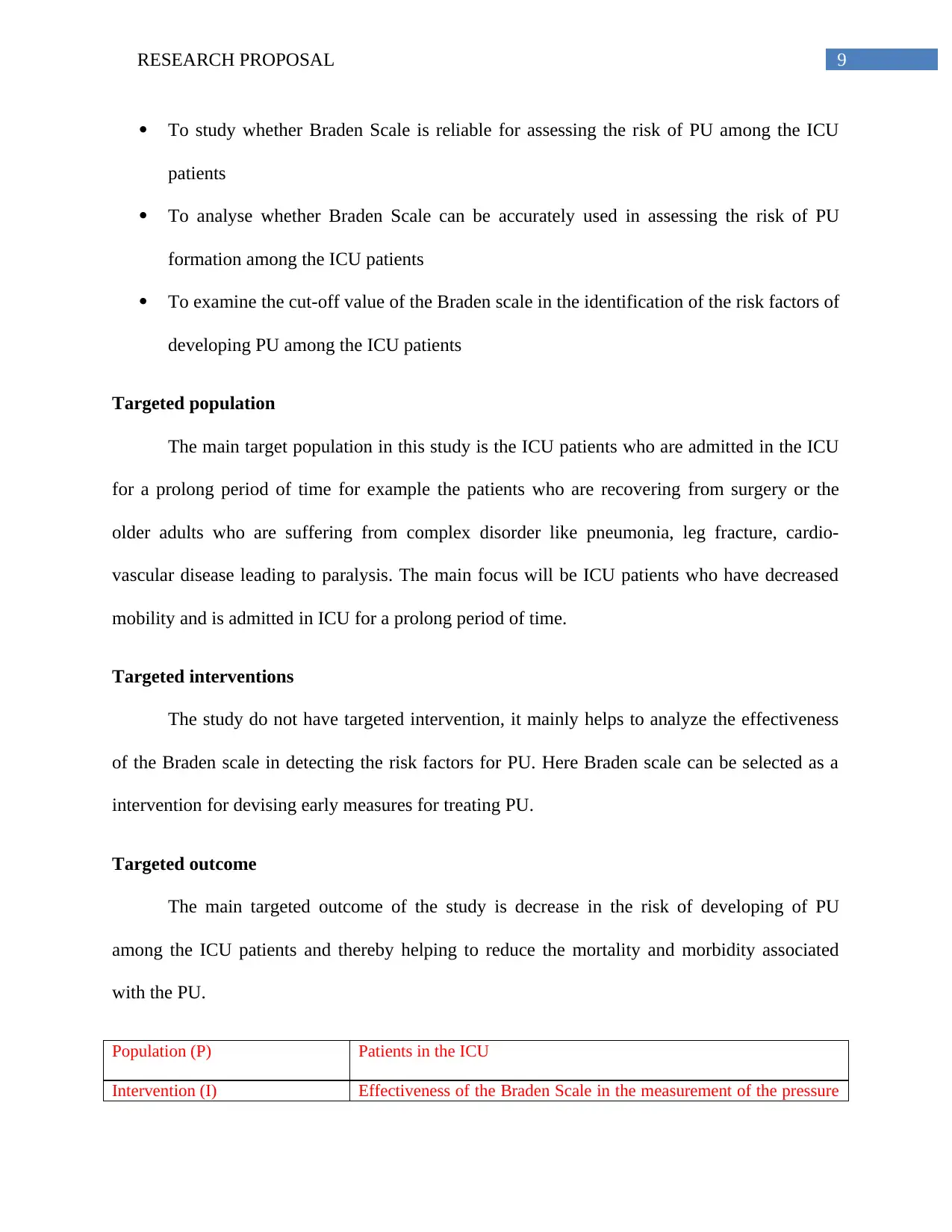
9RESEARCH PROPOSAL
To study whether Braden Scale is reliable for assessing the risk of PU among the ICU
patients
To analyse whether Braden Scale can be accurately used in assessing the risk of PU
formation among the ICU patients
To examine the cut-off value of the Braden scale in the identification of the risk factors of
developing PU among the ICU patients
Targeted population
The main target population in this study is the ICU patients who are admitted in the ICU
for a prolong period of time for example the patients who are recovering from surgery or the
older adults who are suffering from complex disorder like pneumonia, leg fracture, cardio-
vascular disease leading to paralysis. The main focus will be ICU patients who have decreased
mobility and is admitted in ICU for a prolong period of time.
Targeted interventions
The study do not have targeted intervention, it mainly helps to analyze the effectiveness
of the Braden scale in detecting the risk factors for PU. Here Braden scale can be selected as a
intervention for devising early measures for treating PU.
Targeted outcome
The main targeted outcome of the study is decrease in the risk of developing of PU
among the ICU patients and thereby helping to reduce the mortality and morbidity associated
with the PU.
Population (P) Patients in the ICU
Intervention (I) Effectiveness of the Braden Scale in the measurement of the pressure
To study whether Braden Scale is reliable for assessing the risk of PU among the ICU
patients
To analyse whether Braden Scale can be accurately used in assessing the risk of PU
formation among the ICU patients
To examine the cut-off value of the Braden scale in the identification of the risk factors of
developing PU among the ICU patients
Targeted population
The main target population in this study is the ICU patients who are admitted in the ICU
for a prolong period of time for example the patients who are recovering from surgery or the
older adults who are suffering from complex disorder like pneumonia, leg fracture, cardio-
vascular disease leading to paralysis. The main focus will be ICU patients who have decreased
mobility and is admitted in ICU for a prolong period of time.
Targeted interventions
The study do not have targeted intervention, it mainly helps to analyze the effectiveness
of the Braden scale in detecting the risk factors for PU. Here Braden scale can be selected as a
intervention for devising early measures for treating PU.
Targeted outcome
The main targeted outcome of the study is decrease in the risk of developing of PU
among the ICU patients and thereby helping to reduce the mortality and morbidity associated
with the PU.
Population (P) Patients in the ICU
Intervention (I) Effectiveness of the Braden Scale in the measurement of the pressure
Paraphrase This Document
Need a fresh take? Get an instant paraphrase of this document with our AI Paraphraser
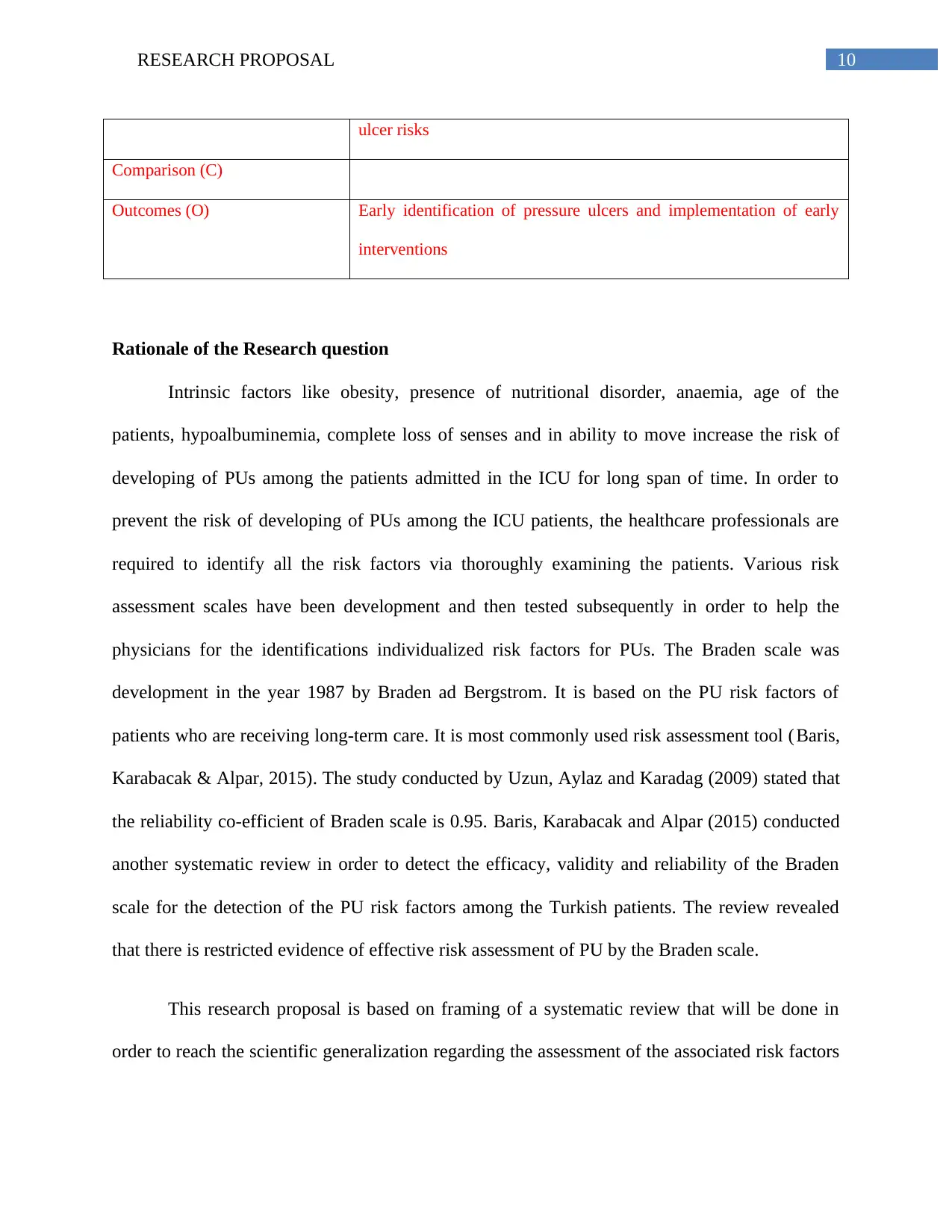
10RESEARCH PROPOSAL
ulcer risks
Comparison (C)
Outcomes (O) Early identification of pressure ulcers and implementation of early
interventions
Rationale of the Research question
Intrinsic factors like obesity, presence of nutritional disorder, anaemia, age of the
patients, hypoalbuminemia, complete loss of senses and in ability to move increase the risk of
developing of PUs among the patients admitted in the ICU for long span of time. In order to
prevent the risk of developing of PUs among the ICU patients, the healthcare professionals are
required to identify all the risk factors via thoroughly examining the patients. Various risk
assessment scales have been development and then tested subsequently in order to help the
physicians for the identifications individualized risk factors for PUs. The Braden scale was
development in the year 1987 by Braden ad Bergstrom. It is based on the PU risk factors of
patients who are receiving long-term care. It is most commonly used risk assessment tool (Baris,
Karabacak & Alpar, 2015). The study conducted by Uzun, Aylaz and Karadag (2009) stated that
the reliability co-efficient of Braden scale is 0.95. Baris, Karabacak and Alpar (2015) conducted
another systematic review in order to detect the efficacy, validity and reliability of the Braden
scale for the detection of the PU risk factors among the Turkish patients. The review revealed
that there is restricted evidence of effective risk assessment of PU by the Braden scale.
This research proposal is based on framing of a systematic review that will be done in
order to reach the scientific generalization regarding the assessment of the associated risk factors
ulcer risks
Comparison (C)
Outcomes (O) Early identification of pressure ulcers and implementation of early
interventions
Rationale of the Research question
Intrinsic factors like obesity, presence of nutritional disorder, anaemia, age of the
patients, hypoalbuminemia, complete loss of senses and in ability to move increase the risk of
developing of PUs among the patients admitted in the ICU for long span of time. In order to
prevent the risk of developing of PUs among the ICU patients, the healthcare professionals are
required to identify all the risk factors via thoroughly examining the patients. Various risk
assessment scales have been development and then tested subsequently in order to help the
physicians for the identifications individualized risk factors for PUs. The Braden scale was
development in the year 1987 by Braden ad Bergstrom. It is based on the PU risk factors of
patients who are receiving long-term care. It is most commonly used risk assessment tool (Baris,
Karabacak & Alpar, 2015). The study conducted by Uzun, Aylaz and Karadag (2009) stated that
the reliability co-efficient of Braden scale is 0.95. Baris, Karabacak and Alpar (2015) conducted
another systematic review in order to detect the efficacy, validity and reliability of the Braden
scale for the detection of the PU risk factors among the Turkish patients. The review revealed
that there is restricted evidence of effective risk assessment of PU by the Braden scale.
This research proposal is based on framing of a systematic review that will be done in
order to reach the scientific generalization regarding the assessment of the associated risk factors
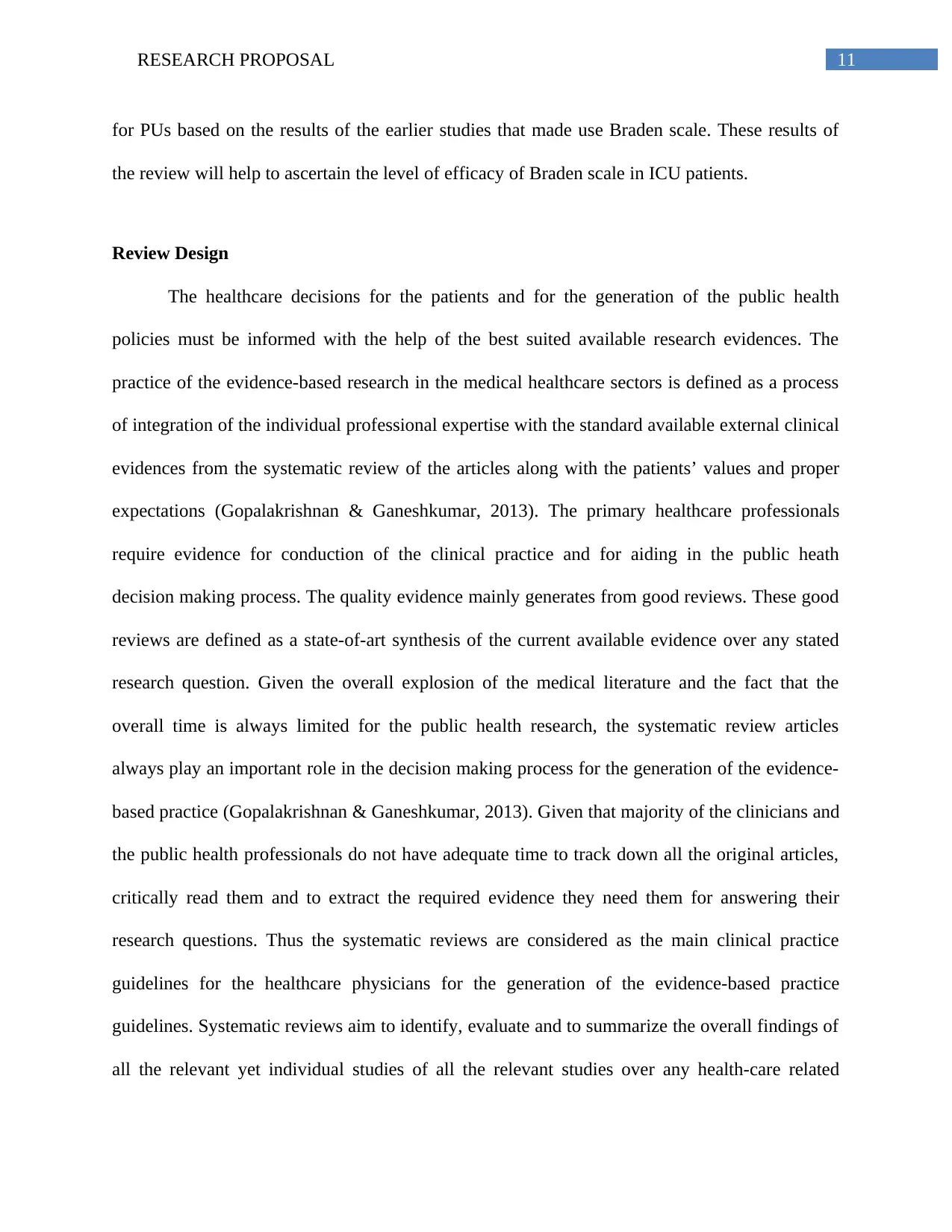
11RESEARCH PROPOSAL
for PUs based on the results of the earlier studies that made use Braden scale. These results of
the review will help to ascertain the level of efficacy of Braden scale in ICU patients.
Review Design
The healthcare decisions for the patients and for the generation of the public health
policies must be informed with the help of the best suited available research evidences. The
practice of the evidence-based research in the medical healthcare sectors is defined as a process
of integration of the individual professional expertise with the standard available external clinical
evidences from the systematic review of the articles along with the patients’ values and proper
expectations (Gopalakrishnan & Ganeshkumar, 2013). The primary healthcare professionals
require evidence for conduction of the clinical practice and for aiding in the public heath
decision making process. The quality evidence mainly generates from good reviews. These good
reviews are defined as a state-of-art synthesis of the current available evidence over any stated
research question. Given the overall explosion of the medical literature and the fact that the
overall time is always limited for the public health research, the systematic review articles
always play an important role in the decision making process for the generation of the evidence-
based practice (Gopalakrishnan & Ganeshkumar, 2013). Given that majority of the clinicians and
the public health professionals do not have adequate time to track down all the original articles,
critically read them and to extract the required evidence they need them for answering their
research questions. Thus the systematic reviews are considered as the main clinical practice
guidelines for the healthcare physicians for the generation of the evidence-based practice
guidelines. Systematic reviews aim to identify, evaluate and to summarize the overall findings of
all the relevant yet individual studies of all the relevant studies over any health-care related
for PUs based on the results of the earlier studies that made use Braden scale. These results of
the review will help to ascertain the level of efficacy of Braden scale in ICU patients.
Review Design
The healthcare decisions for the patients and for the generation of the public health
policies must be informed with the help of the best suited available research evidences. The
practice of the evidence-based research in the medical healthcare sectors is defined as a process
of integration of the individual professional expertise with the standard available external clinical
evidences from the systematic review of the articles along with the patients’ values and proper
expectations (Gopalakrishnan & Ganeshkumar, 2013). The primary healthcare professionals
require evidence for conduction of the clinical practice and for aiding in the public heath
decision making process. The quality evidence mainly generates from good reviews. These good
reviews are defined as a state-of-art synthesis of the current available evidence over any stated
research question. Given the overall explosion of the medical literature and the fact that the
overall time is always limited for the public health research, the systematic review articles
always play an important role in the decision making process for the generation of the evidence-
based practice (Gopalakrishnan & Ganeshkumar, 2013). Given that majority of the clinicians and
the public health professionals do not have adequate time to track down all the original articles,
critically read them and to extract the required evidence they need them for answering their
research questions. Thus the systematic reviews are considered as the main clinical practice
guidelines for the healthcare physicians for the generation of the evidence-based practice
guidelines. Systematic reviews aim to identify, evaluate and to summarize the overall findings of
all the relevant yet individual studies of all the relevant studies over any health-care related
⊘ This is a preview!⊘
Do you want full access?
Subscribe today to unlock all pages.

Trusted by 1+ million students worldwide
1 out of 31
Related Documents
Your All-in-One AI-Powered Toolkit for Academic Success.
+13062052269
info@desklib.com
Available 24*7 on WhatsApp / Email
![[object Object]](/_next/static/media/star-bottom.7253800d.svg)
Unlock your academic potential
Copyright © 2020–2025 A2Z Services. All Rights Reserved. Developed and managed by ZUCOL.





